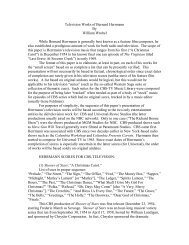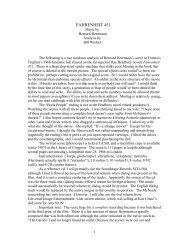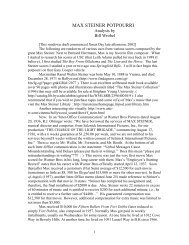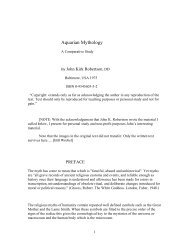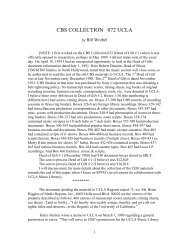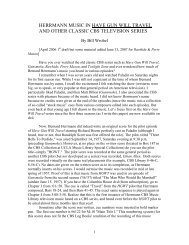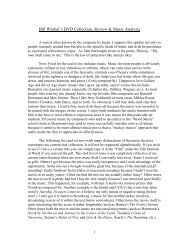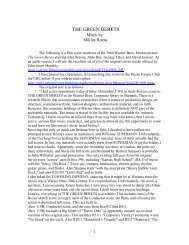Valentine's Day, Sunday, February 14, 2010 at 10:20 am
Valentine's Day, Sunday, February 14, 2010 at 10:20 am
Valentine's Day, Sunday, February 14, 2010 at 10:20 am
- No tags were found...
Create successful ePaper yourself
Turn your PDF publications into a flip-book with our unique Google optimized e-Paper software.
9And wh<strong>at</strong> does the "85" mean??)It is interesting th<strong>at</strong> you are under the spell of a rel<strong>at</strong>ively obscure or little discussedfe<strong>at</strong>ure film score by Herrmann. Probably the least talked about (or ever!) is A H<strong>at</strong>ful ofRain.At any r<strong>at</strong>e, since you are under the spell, here is an appropri<strong>at</strong>e cue for studypurposes:{Image http://img<strong>10</strong>1.imageshack.us/img<strong>10</strong>1/9863/img0002uk.jpghttp://img<strong>10</strong>1.imageshack.us/img<strong>10</strong>1/9863/img0002uk.jpg_______________________________________________talkingherrmann mailing list***********************Talking Herrmann: hangover squareReply by: Bill Wrobel ()______________________________________________________________________HangoverNerve85:Below for study purposes is "The C<strong>at</strong>" cue from the score. Interesting th<strong>at</strong> Herrmannhas the altern<strong>at</strong>e flutes playing gliss technique once the c<strong>at</strong> appears. Such a universaldevice (usually with violins) used by film music composers, including Waxman in hisJack Benny score, Horn Blows <strong>at</strong> Midnight, Max Steiner (such as in Distant Trumpet)when it involves c<strong>at</strong>s or, especially, "c<strong>at</strong>ty" femme f<strong>at</strong>ale line.In Herrmann's cue, it appears th<strong>at</strong> the piccolo in Bar 5 plays Line 1 B quarter notegliss up to Line 2 Ab 8th initially, and th<strong>at</strong>'s a very dissonant m7 interval, and then itsounds Line 1 A quarter note gliss up to Line 2 Eb, and th<strong>at</strong>'s a r<strong>at</strong>her expected (forHerrmann!) tritone interval--in this case, the dim 5th interval. So, hinted <strong>at</strong> musically asconstructed, it's not going to be a pleasant episode, th<strong>at</strong> scene!In the Waxman R8/3 segment bars, we have the violins in harmonics playing the risingto falling c<strong>at</strong>ty glisses. The flutes play the fully written out "11" figure on the rise. This issuch a gre<strong>at</strong> score. I always enjoy listening to it. I don't know if it would sell well if rerecordedbut it is a masterful, fun score. I believe Stalling was involved in the final cue(s)action scenes but I'll have to check my notes. But I don't recall seeing Stallings's n<strong>am</strong>ewritten down on the music there th<strong>at</strong> I researched--but I did not have the cue sheets.I'm looking for the Steiner segment and the c<strong>at</strong>call violins device, but so far I cannotloc<strong>at</strong>e my notes. Maybe I'll include it l<strong>at</strong>er....{Image http://img695.imageshack.us/img695/2794/img0003jq.jpg170




